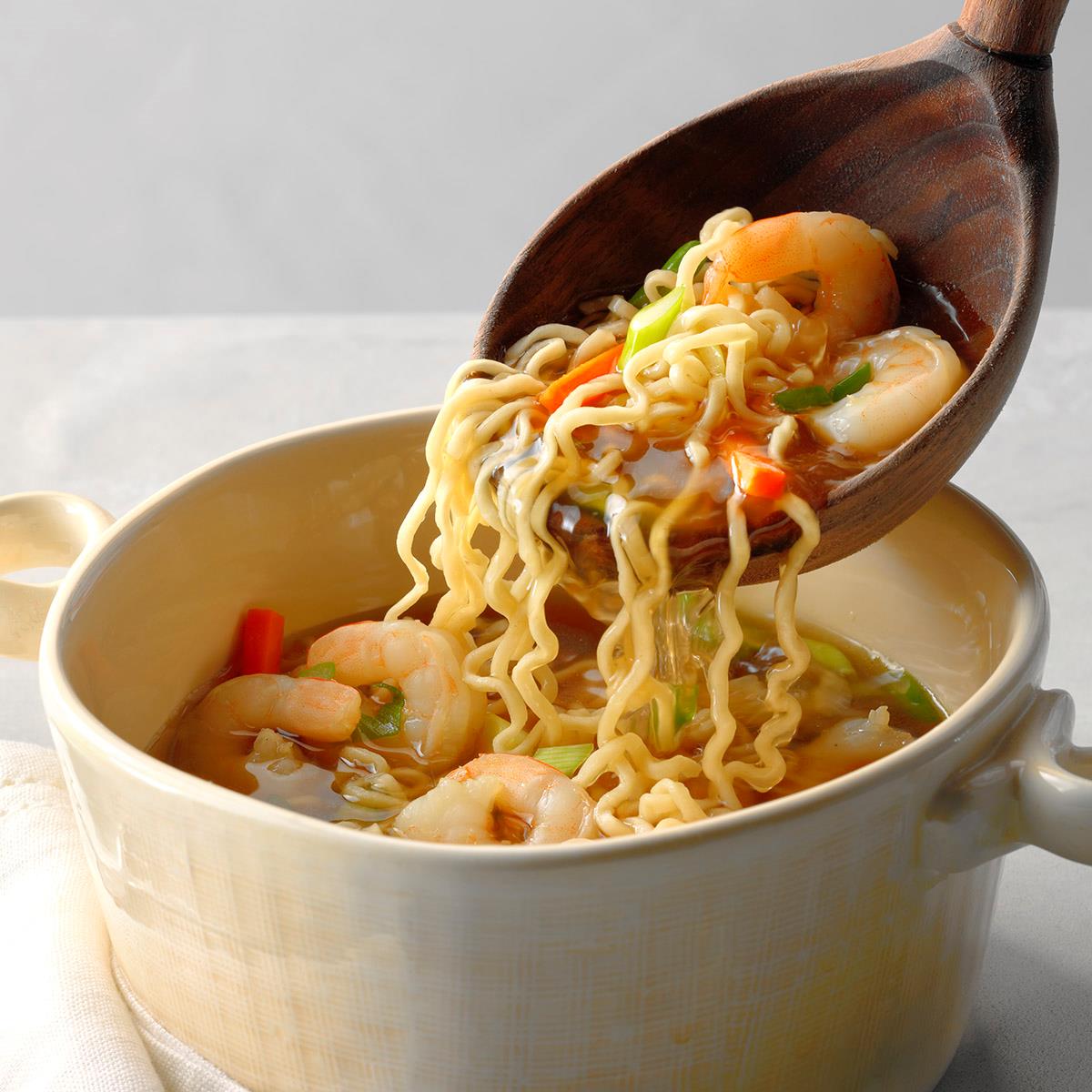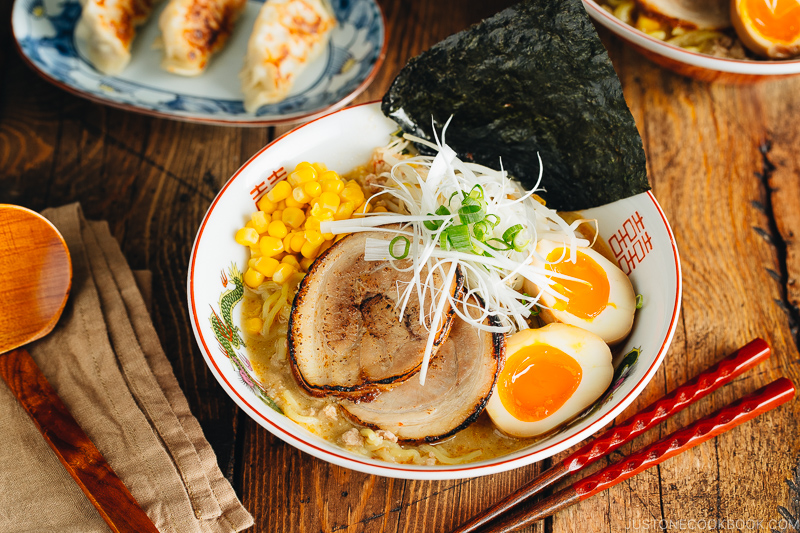Japanese Prawn Ramen is a delicious and satisfying dish that combines the delicate flavors of prawns with the comforting goodness of ramen noodles. This fusion of seafood and Japanese culinary traditions creates a unique and delectable experience for ramen enthusiasts.
In Japanese cuisine, seafood plays a prominent role, and prawns are highly regarded for their sweet and succulent taste. When combined with the umami-rich broth and the springy texture of ramen noodles, the result is a harmonious blend of flavors and textures that will leave you craving for more.

Japanese Prawn Ramen Recipe
Ingredients
Equipment
Method
- Take a pan.
- Add in the oil and onions.
- Cook the onions until they become soft and fragrant.
- Add in the chopped garlic and ginger.
- Cook the mixture and add the tomatoes into it.
- Add the spices.
- Add the miso paste into it when the tomatoes are done.
- Mix the ingredients carefully and cover the pan.
- Add the prawns, vegetables and rest of the ingredients except the noodles.
- Let the mixture boil.
- Add the ramen noodles into the soup mixture.
- Let the soup cook for ten to fifteen minutes straight.
- Add cilantro on top.
- Your dish is ready to be served.
Video
Notes
Some frequently asked questions (FAQs) about Japanese Prawn Ramen:
1. What kind of prawns should I use for Japanese Prawn Ramen?
– It’s best to use fresh, high-quality prawns for the best flavor. Look for large, deveined prawns with their shells removed. You can use either fresh or frozen prawns, but ensure they are properly thawed before cooking.
2. Can I use a different type of seafood instead of prawns?
– Absolutely! While prawns are traditional for this recipe, you can experiment with other types of seafood such as shrimp, scallops, or even a combination of seafood. Adjust the cooking times accordingly to ensure proper cooking.
3. Can I make the broth in advance?
– Yes, you can make the broth in advance to save time. Prepare the broth, allow it to cool, and then store it in an airtight container in the refrigerator for up to a few days. Reheat it gently before using it to assemble your ramen.
4. Can I use pre-packaged ramen noodles?
– While pre-packaged ramen noodles can be used as a shortcut, they may not have the same texture or flavor as fresh ramen noodles. If possible, opt for fresh ramen noodles from an Asian grocery store for an authentic experience. Alternatively, you can try making your own homemade ramen noodles.

5. How can I adjust the spiciness level?
– If you prefer a spicier ramen, you can add chili flakes, chili oil, or a spicy paste of your choice to the broth. Adjust the amount according to your desired heat level. Taste as you go and add more if needed.
6. Can I make a vegetarian version of this recipe?
– Yes, you can make a vegetarian version by using vegetable stock instead of seafood stock and omitting the prawns. Add tofu or other plant-based protein alternatives to make it a satisfying vegetarian ramen.
7. Can I freeze leftover ramen?
– Ramen is best enjoyed fresh, as the noodles can become soggy when frozen and reheated. It is recommended to consume the ramen immediately after preparation. If you have leftover broth or toppings, you can store them separately and assemble a fresh bowl of ramen when desired.
8. Can I customize the toppings and garnishes?
– Absolutely! Ramen is highly customizable, and you can add a variety of toppings and garnishes according to your preferences. Consider adding sliced bamboo shoots, corn kernels, seaweed, or even a sprinkle of sesame seeds for added flavor and texture.
These FAQs should provide some helpful insights as you embark on your culinary journey to create a delicious bowl of Japanese Prawn Ramen. Feel free to experiment and tailor the recipe to suit your taste preferences. Enjoy the process and savor the delightful flavors of this seafood-infused ramen!
Cooking tips
Here are some cooking tips to help you achieve the best results when making Japanese Prawn Ramen:
1. Use fresh ingredients: Opt for fresh prawns, high-quality seafood stock, and fresh vegetables for the best flavor. Fresh ingredients will enhance the overall taste of your ramen.
2. Don’t overcook the prawns: Prawns cook quickly, so be careful not to overcook them, as they can become rubbery. Cook them just until they turn pink and opaque, usually within a few minutes. Remove them from the heat promptly to prevent overcooking.
3. Skim the broth: While simmering the broth, skim off any impurities or foam that rises to the surface. This helps to achieve a clearer and cleaner broth.
4. Season the broth thoughtfully: Taste the broth as you go and adjust the seasoning accordingly. Add soy sauce, miso paste, or other seasonings gradually, ensuring that the flavors are balanced. Remember, it’s easier to add more seasoning than to fix an overly salty or strongly flavored broth.
5. Prepare the toppings in advance: Chop and prepare all the toppings, such as green onions, bean sprouts, or nori seaweed, before you start cooking. This will make the assembly process smoother and ensure that all the components are ready when you need them.

6. Cook the noodles al dente: Follow the instructions on the package to cook the ramen noodles, but aim for an al dente texture. Overcooking the noodles can result in a mushy consistency. Drain and rinse the cooked noodles with cold water to stop the cooking process and remove excess starch.
7. Serve immediately: Ramen is best enjoyed hot and fresh. Assemble the ramen bowls right before serving to maintain the optimal temperature and texture of the noodles.
8. Garnish generously: Don’t be afraid to garnish your ramen generously with toppings and garnishes. They add texture, color, and additional flavors to the dish, enhancing the overall experience.
9. Experiment with additional flavors: Feel free to experiment with additional flavors and seasonings to personalize your ramen. Add a splash of sesame oil, a drizzle of chili oil, or a squeeze of fresh lime juice for an extra kick of flavor.
10. Enjoy the process: Making Japanese Prawn Ramen is an enjoyable culinary adventure. Take your time, savor the aromas, and enjoy the process of creating a delicious bowl of ramen from scratch. Don’t be afraid to get creative and make adjustments to suit your taste preferences.
By following these cooking tips, you’ll be well on your way to preparing a flavorful and satisfying bowl of Japanese Prawn Ramen.
Serving Suggestions
When it comes to serving Japanese Prawn Ramen, here are some suggestions to enhance your dining experience:
1. Individual Ramen Bowls: Serve the ramen in individual bowls to create an authentic and personalized presentation. Make sure each bowl contains a generous portion of noodles, prawns, and flavorful broth.
2. Top it Off: Garnish each bowl of ramen with an array of toppings to add texture, color, and flavor. Some popular options include sliced green onions, bean sprouts, nori seaweed, sesame seeds, or a soft-boiled egg. Arrange the toppings artistically on top of the noodles for an enticing presentation.
3. Side Dishes: Accompany the ramen with a selection of Japanese side dishes, such as gyoza (dumplings), edamame, or a refreshing cucumber salad. These side dishes provide additional variety and complement the flavors of the ramen.
4. Condiments on the Table: Place condiments such as soy sauce, chili oil, and sesame oil on the table, allowing guests to customize their ramen according to their taste preferences. These condiments add an extra layer of flavor and can be drizzled into the broth or added directly to the noodles.
5. Japanese Tea or Sake: Pair the Japanese Prawn Ramen with a cup of traditional Japanese tea, such as green tea or oolong tea. Alternatively, for those who enjoy alcoholic beverages, consider serving a chilled sake or Japanese beer to complement the flavors of the ramen.

6. Family-Style Sharing: If you prefer a more communal dining experience, consider serving the ramen family-style. Place a large pot or bowl of the prepared ramen in the center of the table, allowing everyone to help themselves and customize their bowls with their desired toppings.
7. Fresh Citrus Accents: Squeeze a bit of fresh lemon or lime juice over the ramen just before serving to add a refreshing citrusy touch. This can brighten the flavors and add a zesty element to the dish.
8. Japanese-Inspired Table Setting: Set the table with Japanese-inspired tableware, such as ceramic bowls, wooden chopsticks, and beautiful chopstick holders. This attention to detail can elevate the dining experience and create an ambiance reminiscent of a Japanese ramen eatery.
9. Enjoy with Chopsticks and Spoons: Provide chopsticks and spoons for an authentic ramen experience. The chopsticks are perfect for picking up noodles and toppings, while spoons are ideal for savoring the broth.
10. Share the Experience: Encourage your guests to share their ramen creations, swap toppings, and discuss their favorite flavors. The joy of enjoying Japanese Prawn Ramen is not only in the taste but also in the shared experience and conversation.
Remember, serving Japanese Prawn Ramen is a personal and creative process. Feel free to adapt these suggestions to your preferences and create a dining experience that is enjoyable and memorable for you and your guests.








